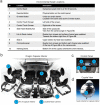This is a preprint.
Collection of Biospecimens from the Inspiration4 Mission Establishes the Standards for the Space Omics and Medical Atlas (SOMA)
- PMID: 37205403
- PMCID: PMC10187258
- DOI: 10.1101/2023.05.02.539108
Collection of Biospecimens from the Inspiration4 Mission Establishes the Standards for the Space Omics and Medical Atlas (SOMA)
Update in
-
Collection of biospecimens from the inspiration4 mission establishes the standards for the space omics and medical atlas (SOMA).Nat Commun. 2024 Jun 11;15(1):4964. doi: 10.1038/s41467-024-48806-z. Nat Commun. 2024. PMID: 38862509 Free PMC article.
Abstract
The SpaceX Inspiration4 mission provided a unique opportunity to study the impact of spaceflight on the human body. Biospecimen samples were collected from the crew at different stages of the mission, including before (L-92, L-44, L-3 days), during (FD1, FD2, FD3), and after (R+1, R+45, R+82, R+194 days) spaceflight, creating a longitudinal sample set. The collection process included samples such as venous blood, capillary dried blood spot cards, saliva, urine, stool, body swabs, capsule swabs, SpaceX Dragon capsule HEPA filter, and skin biopsies, which were processed to obtain aliquots of serum, plasma, extracellular vesicles, and peripheral blood mononuclear cells. All samples were then processed in clinical and research laboratories for optimal isolation and testing of DNA, RNA, proteins, metabolites, and other biomolecules. This paper describes the complete set of collected biospecimens, their processing steps, and long-term biobanking methods, which enable future molecular assays and testing. As such, this study details a robust framework for obtaining and preserving high-quality human, microbial, and environmental samples for aerospace medicine in the Space Omics and Medical Atlas (SOMA) initiative, which can also aid future experiments in human spaceflight and space biology.
Figures










References
-
- Witze A. 2022 was a record year for space launches. Nature 613, 426 (2023). - PubMed
Publication types
Grants and funding
LinkOut - more resources
Full Text Sources
Research Materials
